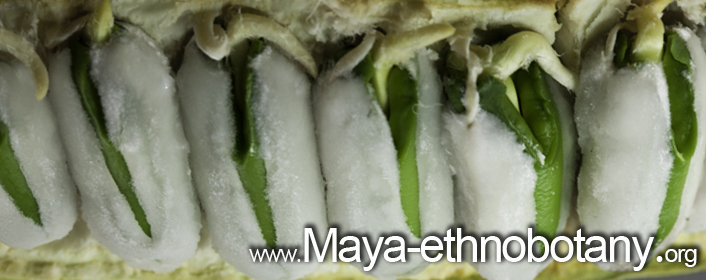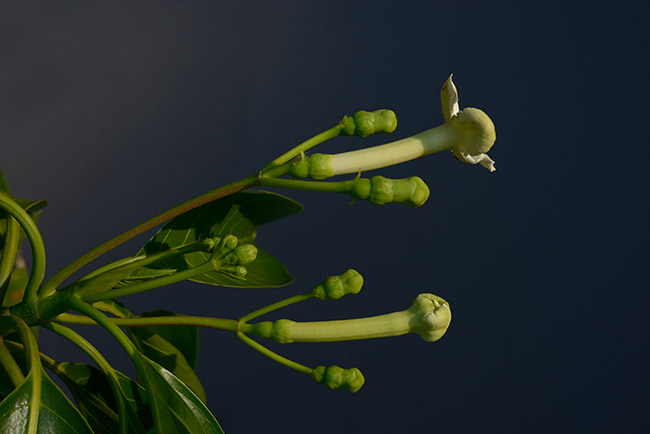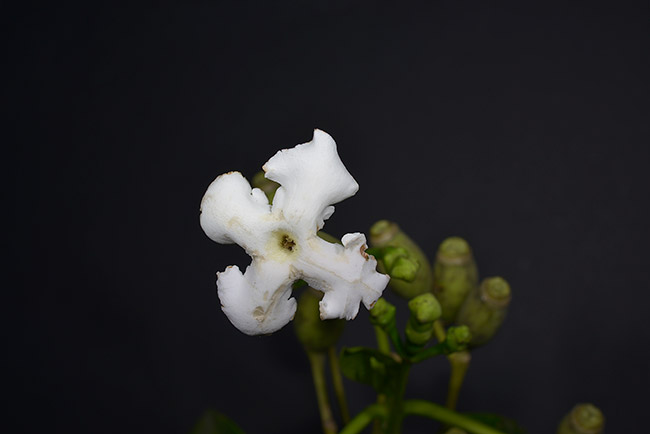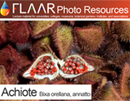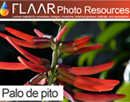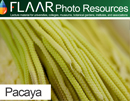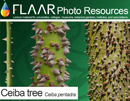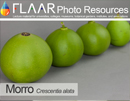When time and funding permit, each flower (each plant species) will have its own page, and its own PDF, and eventually its own PPT so that professors and students have plenty of material on Guatemala (and Honduras, etc) to study.
Heliconia adflexa, Coban, Guatemala, Hotel Monja Blanca, FLAAR, by Nicholas Hellmuth
This space is for flowers
we have recently found and photographed.
|
| Share
|
Blepharidium guatemalense, Irayol blancoBlepharidium guatemalense is called irayol blanco, especially in the Izabal area. We first found this plant when looking for another tree called irayol which is used to produce a colorant. We asked for irayol and were shown the tree with the white flower, Blepharidium guatemalense. It took a while to find Genipa americana. Ironically both were growing in the same field, adjacent to Frutas del Mundo, where Dwight Carter has his fruit tree gardens. We do not yet have the Q’eqchi’ Mayan name since our Q’eqchi’ assistants come from the Highlands of Alta Verapaz where irayol does not grow (so they don’t know the local Mayan names).
When you Google or Bing “irayol” you get 90% of the returns for the villages of this name, one in Guatemala, one in El Salvador. You can’t subtract Guatemala because then you would not get any web sites on the tree irayol in this country! For returns which are actually on plants, most are on Genipa americana and only a few are on Blepharidium guatemalense. Genipa americana produces a colorant which is used for body painting or temporary Easy to find on both sides of Lake Izabal, Guatemala This tree is common around the Polochic area of Izabal. There are many trees near the farm of Frutas del Mundo (south side of the Lake Izabal). I found abundant trees growing along the highway several kilometers west of the Exmibal mineral processing factory (now owned by a Russian company and probably a different company name, but everyone still calls it Exmibal). Pittier found a speciman along the Saklak River, Secanquim, Alta Verapaz, Guatemala, Central America. Most of Alta Verapaz is accessible nowadays if you have a high axel 4WD pickup truck. There is an aldea El Irayol in San Juan Tecuaco, Santa Rosa Guatemala, and an El Irayol, Cabanas, El Salvador. We will need to visit each location to learn whether they mean Blepharidium guatemalense or more likely Genipa americana. One web site associates El Irayol with San Juan Tecuaco; another web site associates the aldea with the municipio of Santa Maria Ixhuatan.
This is an attractive flowering tree to grow in your garden The flowers are fragrant and attractive. The tree is not oversized. In general this would be a good tree for gardens (assuming that the leaves and bark are not poisonous, as reputed around Huehuetenango.
BIBLIOGRAPHY on Blepharidium guatemalense CONABIO LORENCE, D. H. PEREZ, A., SOUSA Sanchez, M. HANAN-Alipi, A. M., CHIANG Cabrera, F. and P. TENORIO L. STANDLEY, P. C. and L. O. WILLIAMS DAVIDSE, G., SOUSA Sanchez, M., KNAPP, S. and F. CHIANG Cabrera.
Web sites with pages on Blepharidium guatemalense www.cicy.mx/sitios/flora%20digital/ficha_virtual.php?especie=2016 http://eol.org/pages/1096132/details The EOL page on Blepharidium guatemalense is really sad. The range description for Blepharidium guatemalense is incomplete. Considering who is funding EOL, it is sad to see the lack of up to date information which is so painfully obvious from this site. I am not a botanist, and I do not have funding from the MacArthur Foundation, but I have 78,000 photographs of flowers and plants of Guatemala merely in the last four years. EOL and several other comparable sites are not providing a realistic scholarly contribution. All I find is out of date references from sources already known. Even TREES OF GUATEMALA by Parker does better at copying-and-pasting from botanical monographs. A content farm is a bunch of material copied and pasted from obvious sources. A botanist, hopefully, would like to know more realistic facts, and would hopefully prefer some actual factual field work results. This tree, Blepharidium guatemalense, irayol blanco, is common on both sides of Lake Izabal in Guatemala, and I would estimate is common in a few other areas of Guatemala (though on endangered list, which is good, since most of Guatemala is being bulldozed for teak plantations, African oil palm, and Brazil rubber trees). Two days ago I had in front of me more Blepharidium guatemalense, than the EOL site seems to be aware of. And these were so plentiful it was like weeds along the highway: you did not even have to go on a botanical expedition. The same earlier this year: Blepharidium guatemalense all over the place on the south side of the lake. Sorry, but if no one writes to point this out, there will be no awareness of the need for a complete overhaul of the goals of this site. Merely pumping more money into the site is not the answer.
Appendix A The basic data on Blepharidium guatemalense which is copied-and-pasted everywhere (sometimes with not really full citation). Standley and Williams, Flora of Guatemala. Blepharidium guatemalense Standl. Journ. Wash. Acad. Sci. 8: 59. 1918. Popiste; polo de estricnina; irayol bianco; irayol. Usually in hilly pine forest, sometimes in savannas, 300 m. or lower; endemic; Petn; Alta Verapaz (type from forest along Rio Saclac below Secanqulm, Pittier 266); Izabal (Quiriqua; Cristina; Santa Cruz); Huehuetenango (Ixcan). A shrub or small tree, usually 1.5-5.5 m. tall, sometimes a tree of 6-18 m., the branchlets glabrous; stipules ovate-triangular, 2-2.5 cm. long, acuminate, brown, glabrous outside, sericeous within at the base; petioles stout, 2.5-5 cm. long, glabrous; leaf blades oval-oblong to oblanceolate or oblong-obovate, 15-35 cm. long, 4-21 cm. broad, obtuse to acute or abruptly short-acuminate, obtuse to attenuate at the base, The shrub is plentiful on the brushy pine hillsides above Quiriagua Hospital. It is probable that B. mexicanum also is to be found in northern Peten. It differs in having smaller flowers, the corolla tube only 4 cm. long, and sparse pubescence over the lower leaf surface. The wood is used for rafters, beams, and supports of lowland houses. In Huehuetenango the leaves and bark are reputed poisonous, hence the name "estricnina" given the tree, but it is improbable that poisonous properties are found in this genus. Notes from Nicholas: I assume he means Quirigua Hospital, not Quiriagua. Quirigua is the well known Maya archaeological site. Let us hope that additional field work by experienced botanists can improve the information in this documentation by Standley and Williams. Posted, July 2014 |
Parque Nacional Yaxha, Nakum and Naranjo
Carnivorous Plants
Plants of Municipio de Livingston, Izabal
- Acrostichum danaeifolium, giant leather ferns
- Bellucia Pentamera
- Bibliography on Grias cauliflora
- Bibliography on Licania platypus
- Bibliography on Mangle negro (Avicennia germinans) L.
- Bibliography on Montriacardia arborescens
- Bibliography on Typha domingensis and Thypha latifolia
- Conocarpus erectus, white mangrove
- Edible Wetlands Plants, Hotel Tortugal
- Heliconia latispatha
- Heliconia wagneriana
- Manicaria saccifera Confra palm
- Neotropical trees of Guatemala need protection
- Nymphoides indica, waterlily flowers
- Pachira aquatica, zapoton
- Bibliography on Pithecellobium Mart., Neotropical trees of Mesoamerica
Ecosystems, Wetlands Aquatic Plants
Smartphone Camera Reviews
Bushes and small trees
Fungi and Lichens
Orchids
- Bibliography Bletia purpurea, aquatic orchid
- Bibliography, Epidendrum radicans
- Bibliography on Habenaria Orchids from Yaxha
- Bibliography, Lycaste virginalis var. alba.
- Bibliography, Macroclinium bicolor
- Bibliography, Prosthechea cochleata
- Bibliography Sobralia macrantha, Lirio de San Juan
- Bibliography, Sobralia xantholeuca
- Bibliography on Terrestrial shade orchids from Guatemala
- Bibliography on Terrestrial sunny orchids from Guatemala
Botanical Terms
Maya and Aztec flavorings for cacao, cocoa, chocolate
- Achiote, Bixa orellana
- Bibliography on Achiote, Bixa orellana
- Bibliography on Esquisúchil, Bourreria huanita
- Bourreria huanita
- Cassia grandis, bucut
- Chile Chocolate
- Chile Chocolate (Capsicum annuum var accuminatum)
- Chiranthodendron pentadactylon
- Cymbopetalum penduliflorum
- Guazuma ulmifolia
- Haematoxylum brasiletto
- Piper auritum, hoja santa
- Piper species
- Quararibea funebris
- Sterculia apetala, castaño
- Tagetes sp., Marigold
- Talauma, a variant of Magnolia
- Vanilla orchid
- Virola and nutmeg
Cacao, cocoa, chocolate
Consulting cacao & Theobroma species
Tobacco Ingredients of Aztec & Maya
Trees of Mesoamerica
- Bibliography on Acacia dolichostachya, Wild tamarind
- Bibliography, Bellucia costaricensis
- Bibliography, Bucida buceras
- Bibliography on Coccoloba belizensis Standl.
- Bibliography on Cojoba sp. and Cojoba arborea
- Bibliography, Ficus.
- Bibliography on Haematoxylum campechianum and H. brasiletto
- Bibliography on Hibiscus pernambucensis
- Bibliography on Ipomea murucoides
- Bibliography on Lacmellea standleyi, lechemiel
- Bibliography on Leucaena leucocephala
- Bibliography on mangle rojo (Rhizophora mangle)
- Bibliography on Manzanillo, Alseis yucatanensis Standl.
- Bibliography on Matilisguate, Tabebuia rosea
- Mangrove swamp Trees
- Bibliography on Ruagea insignis
- Bibliography on Pterocarpus officinalis
Bombacaceae, Bombacoideae
Tropical Fruits of the Maya
- Avocado Hass
- Bibliography on Coloc, Talisia floresii
- Bibliography, Dichogamy of avocado species
- Bibliography on Guayo, Talisia olivaeformis
- Bibliography on Laetia thamnia, Bakelac
- Bibliography on Maracuyá, Passiflora quadrangularis L.
- Bibliography on Punica granatum L., Granada
- Cashew
- Cuajilote, Parmentiera aculeata
- Granada
- Guanabas and Annonas
- Guava, Guayaba, Psidium guajava L
- Introduction to Papaya
- Nance a fruit of prehispanic Guatemala
- Passion flowers and fruits
- Passion flower, giant fruit
- Talisia floresii, Sapindaceae
- Carica Papaya Bibliography
Tropical Nuts
Spices, condiments, food coloring
Medicinal Plants
- Aristolochia, The largest flower in Guatemala, Bibliography
- Asclepias curassavica, bibliography
- Bibliography on Ciricote, Cordia dodecandra
- Bibliography on Contrahierba, Dorstenia contrajerva
- Bibliography on Falso hibisco, Malvaviscus arboreus
- Bibliography on Huele de noche, Cestrum nocturnum
- Bibliography on Lirio araña, Hymenocallis littoralis
- Bibliography on Roble Prieto, Ehretia tinifolia
- Bibliography, Tithonia diversifolia
- Canak
- Calliandra general info
- Guava, Guayaba
- Magnolia and Taluma
- Mayan medicinal plants
- Piper
- Tecomasuche, Coclospermum vitifolium
- Bibliography on Sufricay, Malmea depressa
- Bibliography on Wigandia urens
Underutilized edible plants
Edible Plants of the Mayan World
- Acacia, subin, bullhorn acacia
- Bibliography, Annona muricata
- Bibliography, Annona purpurea
- Bibliography, Annona reticulata
- Bibliography on Chipilín, Crotalaria longirostrata
- Bibliography on Chirimoya, Annona squamosa
- Bernoullia flammea
- Canna indica, tamale wrap
- Cuchamper, Gonolobus
- Guava, Guayaba
- Bibliography, Gonobolus sp.
- Bibliography, Parmentiera aculeata
- Pacaya palm Chamaedorea tepejilote
- Split leaf philodendron, Monstera deliciosa
Plants and trees used to produce incense
Utilitarian Plants
- Bibliography, Acacia farnesiana
- Bibliography on Aechmea bromeliifolia
- Bibliography on Agave americana
- Bibliography, native Agave species from Guatemala
- Bibliography on Anthurium crassinervium (Jacq.) Schott
- Bibliography on Balsa, Ochroma pyramidale
- Bibliography on Bamboo, Guadua longifolia (E.Fourn) R.W.Pohl
- Bibliography, Crescentia alata
- Bibliography, Crescentia cujete
- Bibliography on Hule, Castilla elastica
- Blepharidium guatemalense, irayol blanco
- Crescentia alata, Crescentia cujete
- Tecomasuche, Coclospermum vitifolium
- Bibliography on Coxte, Colubrina arborescens
- Bibliography on Madre cacao, Gliricidia sepium
- Bibliography on Tillandsia usneoides
